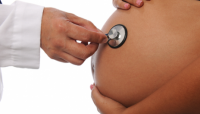Article
Mother, Fetus Compete for Iodine in Pregnancy
Author(s):
The nausea and vomiting that accompanies and compromises what should be a happy time for most expecting mothers is poorly understood.

The nausea and vomiting that accompanies and compromises what should be a happy time for most expecting mothers is poorly understood.
Morning sickness that appears during the first trimester and gradually disappears during the second and third trimesters implicates human chorionic gonadotropin (hCG). Regardless, a clear causal link between hCG and morning sickness has not been established.
Part of the problem is that hCG is not one specific hormone, but a diverse group of functionally and structurally different hormones that share an amino acid backbone. Some researchers think morning sickness occurs when high-quality embryos are capable of robustly producing metabolites that trigger nausea and vomiting in the mother. Embryos of lesser quality, including those with chromosomal abnormalities, may be unable to generate metabolites in quantities large enough to stimulate morning sickness in the mother. In other words, sickness in pregnancy may be an evolutionary conflict between mother and embryo.
The 2014 issue of the Journal of Theoretical Biology contained an article by Scott Forbes, PhD, of the Department of Biology at the University of Winnipeg in Canada, that looked further into morning sickness, examining its possible link to thyroid function in the fetus. Forbes indicated that during gestation, the mother and embryo compete for iodine — an essential micronutrient for neurodevelopment and thyroid function — creating, in some cases, an iodine deficiency. Consequently, some pregnant women develop thyroid disease.
In his thorough review of iodine dynamics throughout pregnancy, Forbes described an “antagonistic pleiotropy” between mother and embryo over iodine allocation. He explained how the embryo benefits at a cost to the mother in conditions of scarce dietary iodine. Throughout evolution, thyroid function in the embryo has evolved to scavenge to iodine economically, so embryos use hCG to hijack maternal thyroid function and find the iodine they need. When it is readily available, the embryo’s undiminished demands create inert metabolites of thyroxine or triiodthyronine that lead to a range of pregnancy sickness symptoms for the mother.
Forbes acknowledged other theories of morning sickness, including those that propose it protects pregnant women and their offspring from food-borne pathogens, mutagens, or teratogens. However, he suggested an absence of morning sickness in older women may indicate that embryonic chromosomal testing is needed. In women younger than 30, he proposed that testing for hypothyroidism may be a more urgent priority.




